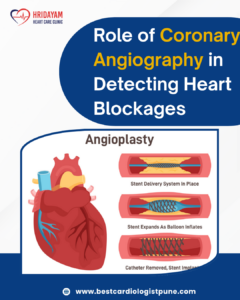Heart health depends on the smooth flow of oxygen-rich blood through the coronary arteries. When these arteries become narrowed or blocked, the heart muscle receives less oxygen, which can lead to discomfort, reduced function, or even cardiac emergencies. Detecting such blockages early plays a key role in managing overall heart wellness.
As explained by the Best Cardiologist in Pune, coronary angiography remains one of the most reliable diagnostic techniques for assessing the condition of the heart’s blood vessels and identifying the severity of any narrowing.
What Is Coronary Angiography?
Coronary angiography is a diagnostic imaging procedure that uses contrast dye and X-rays to visualise the heart’s arteries. It helps determine whether blood flow is restricted due to plaque buildup or other abnormalities.
This procedure is often used when non-invasive tests such as electrocardiograms (ECG), echocardiograms, or stress tests suggest that there may be a problem with blood circulation in the coronary arteries.
During the test, a thin flexible tube known as a catheter is gently guided through a blood vessel, usually from the wrist or groin, toward the coronary arteries. A special dye that appears on X-rays is injected through the catheter, allowing doctors to see detailed images of the arteries and identify any blockages or narrowing.

Why Is Coronary Angiography Important?
The importance of coronary angiography lies in its accuracy and detailed visualisation of the coronary vessels. It helps medical professionals:
- Identify Blockages:
It reveals the exact location and extent of narrowing or blockage within the coronary arteries. - Determine Severity:
The results indicate whether the narrowing is mild, moderate, or severe, which is important for planning further medical evaluation. - Assess Blood Flow:
The test provides real-time images of how blood moves through the coronary arteries and helps detect any areas of reduced circulation. - Guide Next Steps:
Based on the findings, doctors can decide whether medication, lifestyle adjustments, or further procedures like angioplasty might be appropriate for managing heart function.How Coronary Angiography Helps Detect Heart Blockages
A coronary artery blockage occurs when fatty deposits (plaques) build up inside the arterial walls — a condition known as atherosclerosis. Over time, these plaques can narrow the arteries, restricting oxygen-rich blood from reaching the heart muscle.
Coronary angiography plays a central role in identifying such blockages accurately. The images it produces help pinpoint:- The exact artery affected
- The degree of narrowing
- The pattern and nature of plaque buildup
- Any alternate blood flow routes formed by smaller vessels
By understanding these details, healthcare professionals can evaluate the impact of restricted circulation and ensure timely medical attention when required.
When Is Coronary Angiography Recommended?
Coronary angiography is typically considered when a person experiences persistent symptoms that suggest reduced blood flow to the heart. These symptoms may include:
- Chest pain or discomfort (angina) that worsens with exertion or stress
- Shortness of breath during physical activity
- Unusual fatigue or weakness
- Pain spreading to the neck, jaw, or arm.
- Abnormal ECG or stress test results
It may also be performed after a heart attack to identify the artery responsible for the reduced blood supply and assess the overall condition of the heart’s circulation system.
How the Procedure Works
- Preparation:
Before the test, basic blood tests and imaging assessments are performed. The patient is usually awake but may receive mild sedation to stay relaxed. - Catheter Insertion:
A small area, usually near the wrist or groin, is cleaned and numbed. A thin catheter is inserted into the blood vessel and gently advanced toward the heart. - Contrast Dye Injection:
A special contrast dye is injected through the catheter, and X-ray images are taken in quick succession. - Imaging and Observation:
These X-rays, known as angiograms, show how the dye moves through the coronary arteries, highlighting any blockages or narrowing.
Post-Procedure Monitoring:
After the angiography, patients are observed for a few hours while normal blood flow and vital signs are monitored. The small puncture site is bandaged, and light activity can usually resume within a short period.
Benefits of Coronary Angiography
Coronary angiography offers several diagnostic advantages, including:
- Detailed visualisation of coronary arteries
- Accurate identification of narrowing or blockages
- Assessment of the heart muscle blood supply
- Guidance for further evaluation or lifestyle management
Unlike other tests, it provides a clear and dynamic view of the heart’s circulation system, making it a key diagnostic tool in cardiac care.
Safety and Awareness
Coronary angiography is generally considered a safe and controlled procedure. However, as with any diagnostic test, it is performed only when necessary and under proper medical supervision.
The test offers valuable information that helps in evaluating the overall state of the heart’s arteries without relying solely on external symptoms or assumptions. At the Best Heart Clinic in Pune, emphasis is placed on understanding each individual’s heart condition before any major medical decisions are made.
Understanding the Findings
After angiography, the results are analysed to determine the degree of arterial narrowing. These findings help categorise blockages based on their percentage — for example, mild (less than 50%), moderate (50–70%), or severe (above 70%).
This information assists in understanding how much the heart’s blood flow is affected and whether further evaluation or preventive care is required.
It’s also important to remember that coronary angiography doesn’t automatically mean a person needs additional procedures. Many times, lifestyle adjustments, medication, and regular monitoring are recommended depending on the findings and the person’s overall health status.
Living with Awareness
Maintaining heart health goes beyond diagnostic tests. Lifestyle awareness remains a major part of prevention. Individuals can lower their risk of developing blockages by:
- Eating a diet high in fruits, vegetables, and whole grains
- Staying physically active according to their capacity
- Avoiding tobacco and limiting alcohol consumption
- Managing blood pressure, diabetes, and cholesterol levels
- Reducing stress through mindfulness or relaxation techniques
These steps, combined with timely medical assessments, can help maintain long-term cardiovascular health.
Recognising Subtle Symptoms Early
Heart disease does not always present with intense pain or dramatic symptoms. Some individuals experience only mild fatigue, discomfort in the upper body, or breathlessness during minor activity.
Understanding these subtle signals and discussing them with a healthcare professional can make a significant difference in preventing complications and ensuring early detection of blockages.
Conclusion
Coronary angiography remains a valuable diagnostic tool for evaluating heart health and detecting arterial blockages with precision. It helps visualise the heart’s blood vessels and supports informed medical decisions based on accurate data rather than assumptions.
The Best Cardiologist in Pune highlights the importance of timely diagnosis and awareness in maintaining heart wellness. Recognising symptoms early, following preventive habits, and undergoing appropriate diagnostic tests can help protect the heart’s long-term function and stability.

